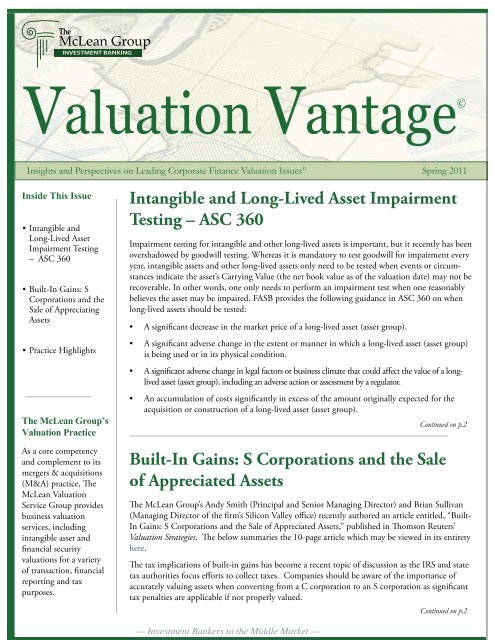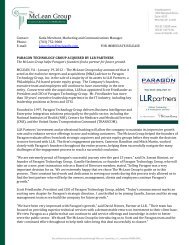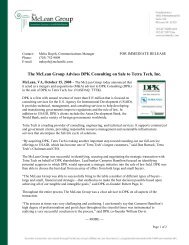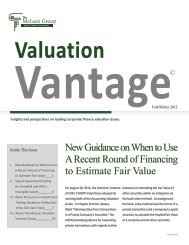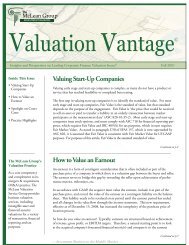Intangible and Long-Lived Asset Impairment Testing - The McLean ...
Intangible and Long-Lived Asset Impairment Testing - The McLean ...
Intangible and Long-Lived Asset Impairment Testing - The McLean ...
Create successful ePaper yourself
Turn your PDF publications into a flip-book with our unique Google optimized e-Paper software.
Valuation Vantage©<br />
Insights <strong>and</strong> Perspectives on Leading Corporate Finance Valuation Issues © Spring 2011<br />
Inside This Issue<br />
• <strong>Intangible</strong> <strong>and</strong><br />
<strong>Long</strong>-<strong>Lived</strong> <strong>Asset</strong><br />
<strong>Impairment</strong> <strong>Testing</strong><br />
– ASC 360<br />
• Built-In Gains: S<br />
Corporations <strong>and</strong> the<br />
Sale of Appreciating<br />
<strong>Asset</strong>s<br />
• Practice Highlights<br />
<strong>The</strong> <strong>McLean</strong> Group’s<br />
Valuation Practice<br />
As a core competency<br />
<strong>and</strong> complement to its<br />
mergers & acquisitions<br />
(M&A) practice, <strong>The</strong><br />
<strong>McLean</strong> Valuation<br />
Service Group provides<br />
business valuation<br />
services, including<br />
intangible asset <strong>and</strong><br />
financial security<br />
valuations for a variety<br />
of transaction, financial<br />
reporting <strong>and</strong> tax<br />
purposes.<br />
<strong>Intangible</strong> <strong>and</strong> <strong>Long</strong>-<strong>Lived</strong> <strong>Asset</strong> <strong>Impairment</strong><br />
<strong>Testing</strong> – ASC 360<br />
<strong>Impairment</strong> testing for intangible <strong>and</strong> other long-lived assets is important, but it recently has been<br />
overshadowed by goodwill testing. Whereas it is m<strong>and</strong>atory to test goodwill for impairment every<br />
year, intangible assets <strong>and</strong> other long-lived assets only need to be tested when events or circumstances<br />
indicate the asset’s Carrying Value (the net book value as of the valuation date) may not be<br />
recoverable. In other words, one only needs to perform an impairment test when one reasonably<br />
believes the asset may be impaired. FASB provides the following guidance in ASC 360 on when<br />
long-lived assets should be tested:<br />
• A significant decrease in the market price of a long-lived asset (asset group).<br />
• A significant adverse change in the extent or manner in which a long-lived asset (asset group)<br />
is being used or in its physical condition.<br />
• A significant adverse change in legal factors or business climate that could affect the value of a longlived<br />
asset (asset group), including an adverse action or assessment by a regulator.<br />
• An accumulation of costs significantly in excess of the amount originally expected for the<br />
acquisition or construction of a long-lived asset (asset group).<br />
Continued on p.2<br />
Built-In Gains: S Corporations <strong>and</strong> the Sale<br />
of Appreciated <strong>Asset</strong>s<br />
<strong>The</strong> <strong>McLean</strong> Group’s Andy Smith (Principal <strong>and</strong> Senior Managing Director) <strong>and</strong> Brian Sullivan<br />
(Managing Director of the firm’s Silicon Valley office) recently authored an article entitled, “Built-<br />
In Gains: S Corporations <strong>and</strong> the Sale of Appreciated <strong>Asset</strong>s,” published in Thomson Reuters’<br />
Valuation Strategies. <strong>The</strong> below summaries the 10-page article which may be viewed in its entirety<br />
here.<br />
<strong>The</strong> tax implications of built-in gains has become a recent topic of discussion as the IRS <strong>and</strong> state<br />
tax authorities focus efforts to collect taxes. Companies should be aware of the importance of<br />
accurately valuing assets when converting from a C corporation to an S corporation as significant<br />
tax penalties are applicable if not properly valued.<br />
Continued on p.2<br />
— Investment Bankers to the Middle Market —
“ASC 360...” continued from p. 1<br />
• A current-period operating or cash flow loss combined<br />
with a history of operating or cash flow losses or a<br />
projection or forecast that demonstrates continuing losses<br />
associated with the use of a long-lived asset (asset group).<br />
• A current expectation that, more likely than not, a longlived<br />
asset (asset group) will be sold or otherwise<br />
disposed of significantly before the end of its previously<br />
estimated useful life.<br />
If an asset group may be impaired, there is a two step test to<br />
verify if the asset actually is impaired. <strong>The</strong> general procedures<br />
related to testing intangible assets are summarized below:<br />
<strong>Intangible</strong> <strong>and</strong> <strong>Long</strong>-<strong>Lived</strong> <strong>Asset</strong> <strong>Impairment</strong> <strong>Testing</strong><br />
Step 1 - Recoverability Test<br />
Determine the Carrying Value of the <strong>Asset</strong> Group<br />
Determine the Sum of Undiscounted Cash Flows of the <strong>Asset</strong> Group<br />
Step 2 - If Carrying Value > Undiscounted Future Cash Flows<br />
Determine Fair Value of the <strong>Asset</strong> Group <strong>and</strong> compare the resulting<br />
Fair Value of the <strong>Asset</strong> Group to its Carrying Value<br />
In Step 1, determine the sum of the undiscounted future cash<br />
flows based on management’s estimates <strong>and</strong> compare it to the<br />
Carrying Value. If the carrying amount is greater than the<br />
sum of the undiscounted cash flows, then the asset is impaired<br />
<strong>and</strong> Step 2 is required. <strong>The</strong> amount of the impairment loss is<br />
the difference between the Fair Value of the asset <strong>and</strong> the Carrying<br />
Value of the asset. A present value technique is often the<br />
best method to estimate the Fair Value of a long-lived asset. If<br />
a present value technique is used, estimates of future cash flows<br />
should be consistent with Fair Value measurement procedures.<br />
Assumptions marketplace participants would use in their estimates<br />
of Fair Value should be incorporated in the analysis.<br />
<strong>The</strong>re are two important takeaways to remember when testing<br />
for impairment. First, if an asset fails Step 1, a severe impairment<br />
loss will most likely be taken for that asset. This is attributable<br />
to the estimated future earnings being undiscounted,<br />
so present valuing those earnings will further decrease the Fair<br />
Value of the asset. Second, even if an intangible or long-lived<br />
asset is not impaired, it may be appropriate to change the useful<br />
life of the asset. Although it is not required to change the useful<br />
life of the asset, one should take the possibility into consideration.<br />
<strong>The</strong> best argument for assessing the useful life is the<br />
fact that events or circumstances have already occurred which<br />
require impairment testing in the first place. Any subsequent<br />
changes to the useful life should be reflected when developing<br />
estimates of future cash flows.<br />
“Built-In Gains...” continued from p. 1<br />
— Investment Bankers to the Middle Market —<br />
In a recent tax court case with Ringgold Telephone Co. vs. the<br />
IRS under Section 1374 of Internal Revenue Code (“IRC”),<br />
many issues arose over the valuation measures followed in<br />
valuing the company’s Fair Market Value of a minority interest.<br />
<strong>The</strong> minority interest was considered to be an appreciating<br />
asset that was sold shortly after the company converted to an S<br />
corporation. <strong>The</strong> Ringgold case is important to valuation practitioners<br />
as it provides insight into how the Tax Court analyzed<br />
the valuation of appreciating assets that may be sold soon after the<br />
election date. Below are some important points from the case:<br />
• Tax code for built-in gains. Under IRC Section 1374<br />
(d)(1), “an S corporation’s gain on disposition of an appreciating<br />
asset is treated as taxable built-in gain to the extent the<br />
Fair Market Value of the asset at the beginning of its first year<br />
in which is it treated as an S corporation exceeds the asset’s<br />
adjusted basis on that date.” A company is taxed on a portion<br />
of the built-in gain if an asset is sold within the recognition<br />
period. Important to note: the recognition period was recently<br />
reduced under the American Recovery <strong>and</strong> Reinvestment Act of<br />
2009 from a 10-year period to a seven-year period.<br />
• Accurate Documentation. All of the factors influencing<br />
the business appraisal need to be accounted for. <strong>The</strong><br />
specific value drivers of a company <strong>and</strong> the economic factors<br />
surrounding the S election date valuation should be clearly<br />
documented to support any change in value that may occur<br />
after the S election date.<br />
• Conversion of C Corp to S Corp. A thorough valuation<br />
of assets is of the utmost importance before converting<br />
from a C Corp to an S Corp. Due to ASC 820’s hierarchy of<br />
Fair Value inputs, there is a potential risk that the sales price<br />
(level 1 input) from selling the appreciating asset close to the S<br />
election valuation date would be considered by the Tax Court<br />
a better indication of value than the value from the business<br />
appraisal on the S election date (level 2 <strong>and</strong> level 3 inputs).<br />
<strong>The</strong>refore, the Tax Court may argue that the accurate Fair<br />
Market Value is the price the assets were sold for after the S<br />
election date <strong>and</strong> not the value represented in the business appraisal<br />
on the S election date, resulting in higher tax penalties.<br />
• Acting Responsibly <strong>and</strong> In Good Faith. <strong>The</strong> Tax Court<br />
considers the taxpayer’s intentions when analyzing tax penalties. A<br />
company should document its efforts in obtaining an accurate valuation<br />
of the appreciating assets to demonstrate it acted responsibly.<br />
Through analyzing the Ringgold case, the benefit to highgrowth<br />
companies making an S election while holding appreciating<br />
assets <strong>and</strong> then selling the assets during the recognition<br />
period is evident. However, a company that plans to do this<br />
must carefully follow the proper precautions of documentation<br />
<strong>and</strong> accurate valuations to safeguard against any potential<br />
tax penalties or negative repercussions.<br />
2
Practice Highlights<br />
<strong>The</strong> <strong>McLean</strong> Valuation Services Group has been actively authoring articles <strong>and</strong> participating<br />
in speaking engagements for various industry-focused publications <strong>and</strong> organization<br />
events, including:<br />
•<br />
•<br />
•<br />
•<br />
•<br />
Andy Smith <strong>and</strong> Brian Sullivan co-authored the article, “We Are Not Paid to<br />
Agree With Our Clients,” for the Financial Valuation <strong>and</strong> Litigation Expert’s<br />
April/May 2011 edition.<br />
Andy Smith was a speaker <strong>and</strong> panelist for SECAF’s, “Educational Forum<br />
Secrets of Success – Underst<strong>and</strong>ing Value Drivers in a Government Contractor,”<br />
in March 2011.<br />
Brian Sullivan <strong>and</strong> Andy Smith authored the article, “Built-in Gains – S Corporations<br />
<strong>and</strong> the Sale of Appreciated <strong>Asset</strong>s,” for Thomson Reuter’s January/<br />
February edition of Valuation Strategies.<br />
Andy Smith presented, “<strong>The</strong> Art of M&A: Valuation,” at a national webinar<br />
presented by eKnow in January 2011.<br />
Zane Markowitz, Brian Sullivan <strong>and</strong> Andy Smith co-authored the article, “Keys<br />
to Creating a Sustainable <strong>and</strong> Productive Financial Forecast,” for NACVA Ambassadors’<br />
QuickRead’s December 2010 edition.<br />
<strong>The</strong> <strong>McLean</strong> Valuation Services Group Offices<br />
<strong>The</strong> <strong>McLean</strong> Group is a national middle market investment bank providing mergers & acquisitions (M&A), capital<br />
formation, market intelligence, business valuation, litigation support <strong>and</strong> exit planning services with bankers in more<br />
than 30 offices in the US. Its affiliate, <strong>The</strong> <strong>McLean</strong> Valuation Services Group, performs business valuation services for<br />
transaction, financial reporting <strong>and</strong> tax purposes. <strong>The</strong> <strong>McLean</strong> Valuation Services Group has dedicated business valuation<br />
offices in the following locations:<br />
Washington, DC, Headquarters<br />
Andy Smith, CPA/ABV, ASA, CVA, CMA<br />
7900 Westpark Drive, Suite A320<br />
<strong>McLean</strong>, VA 22102<br />
703.827.0233<br />
asmith@mcleanllc.com<br />
Austin, TX Office<br />
Shari Overstreet, CPA/ABV, CVA, CM&AA<br />
401 Congress Avenue, Suite 1540<br />
Austin, TX 78701<br />
512.751.7213<br />
soverstreet@mcleanllc.com<br />
Silicon Valley, CA Office<br />
Brian Sullivan, CPA/ABV, CVA, CFE, CBA<br />
177 Bovet Road, Sixth Floor<br />
San Mateo, CA 94402<br />
650.638.2310<br />
bsullivan@mcleanllc.com<br />
— Investment Bankers to the Middle Market —<br />
3


